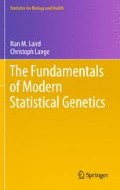Abstract
The goal of linkage analysis in human disease gene mapping is to assess whether an observed genetic marker locus is physically linked to the disease locus. This is equivalent to testing the null-hypothesis that the recombination fraction between the marker locus and the disease locus, θ, equals ½. In this case, we say the marker locus and the disease locus are unlinked. It is also possible to estimate θ, which can be used to provide an approximate idea of the location of the DSL relative to observed markers. In this chapter, we discuss the basic concepts of parametric linkage analysis. We explain how linkage between two genetic loci can be utilized to construct long-range mapping approaches that require only a small number of marker loci per chromosome to cover the entire human genome sufficiently. Using fully parameterized statistical models, parametric linkage describes the phenotype as a function of the genetic marker locus and its relative distance to the disease locus, i.e., the recombination fraction (Ott (1999)). The simplest case of parametric linkage analysis uses the method of direct counting, where θ can be estimated by directly counting recombinant and non-recombinant offspring haplotypes (Ott (1979)). Using the method of direct-counting, we outline the principles of parametric linkage analysis. Advanced topics such as non-parametric linkage analysis and multi-point analysis (Kruglyak et al. (1996)) are discussed in Appendix A. While the advanced topics that are included in Appendix A are necessary for a thorough grounding in linkage analysis, they are not required for an introduction to association analysis.
Access this chapter
Tax calculation will be finalised at checkout
Purchases are for personal use only
Bibliography
Altmueller J, Palmer L, Fischer G, Scherb H, Wjst M (2001) Genomewide scans of complex human diseases: true linkage is hard to find. The American Journal of Human Genetics 69(5):936–950
Clerget-Darpoux F, Bonaïti-Pellié C, Hochez J (1986) Effects of misspecifying genetic parameters in lod score analysis. Biometrics 42(2):393–399
Elston R (1998) Methods of linkage analysis – and the assumptions underlying them. The American Journal of Human Genetics 63(4):931–934
Kruglyak L, Lander E (1995) Complete multipoint sib-pair analysis of qualitative and quantitative traits. American Journal of Human Genetics 57(2):439
Kruglyak L, Daly M, Reeve-Daly M, Lander E (1996) Parametric and nonparametric linkage analysis: a unified multipoint approach. American Journal of Human Genetics 58(6):1347
Lander E, Green P (1987) Construction of multilocus genetic linkage maps in humans. Proceedings of the National Academy of Sciences of the United States of America 84:2363–2367
Morton N (1955) Sequential tests for the detection of linkage. American Journal of Human Genetics 7(3):277–318
Ott J (1979) Maximum likelihood estimation by counting methods under polygenic and mixed models in human pedigrees. The American Journal of Human Genetics 31(2):161
Ott J (1999) Analysis of Human Genetic Linkage. The Johns Hopkins University Press, Baltimore, MD
Self S, Liang KL (1987) Asymptotic properties of maximum likelihood estimators and likelihood ratio tests under nonstandard conditions. Journal of the American Statistical Association 82:605–610
Sham P (1998) Statistics in Human Genetics. Oxford University Press, New York, NY
Thomas D (2004) Statistical Methods in Genetic Epidemiology. Wiley, New York, NY
Wald A (1947) Sequential Analysis. Wiley, New York, NY
Author information
Authors and Affiliations
Corresponding author
Rights and permissions
Copyright information
© 2011 Springer Science+Business Media. LLC
About this chapter
Cite this chapter
Laird, N.M., Lange, C. (2011). Basic Concepts of Linkage Analysis. In: The Fundamentals of Modern Statistical Genetics. Statistics for Biology and Health. Springer, New York, NY. https://doi.org/10.1007/978-1-4419-7338-2_6
Download citation
DOI: https://doi.org/10.1007/978-1-4419-7338-2_6
Published:
Publisher Name: Springer, New York, NY
Print ISBN: 978-1-4419-7337-5
Online ISBN: 978-1-4419-7338-2
eBook Packages: Mathematics and StatisticsMathematics and Statistics (R0)

